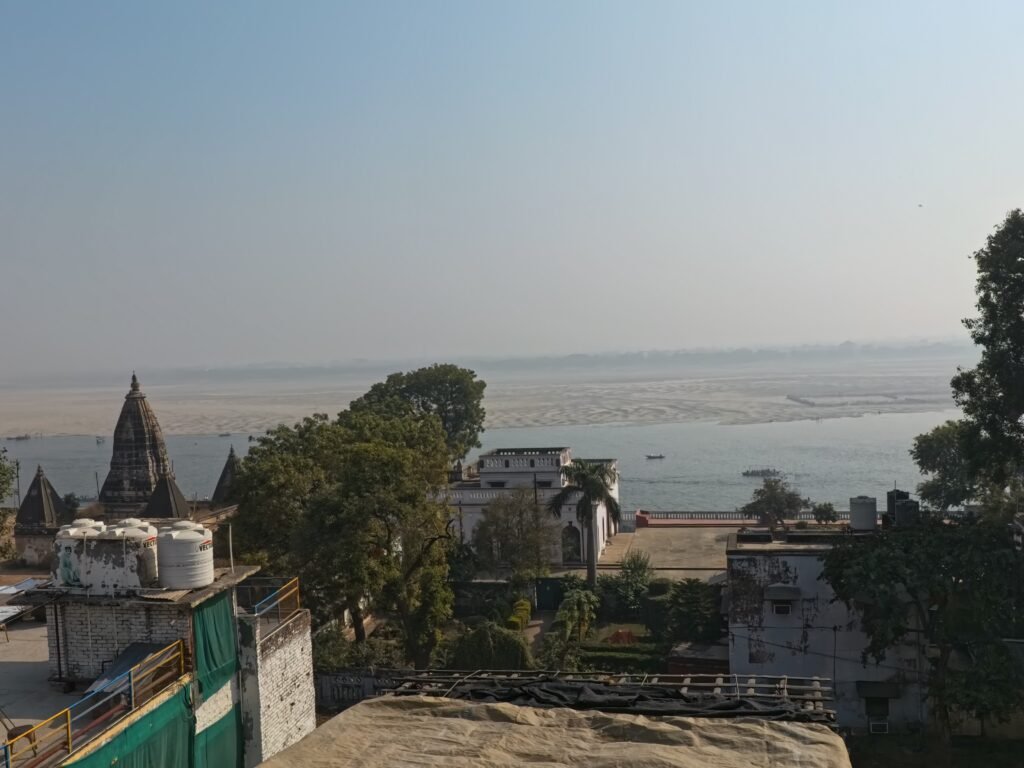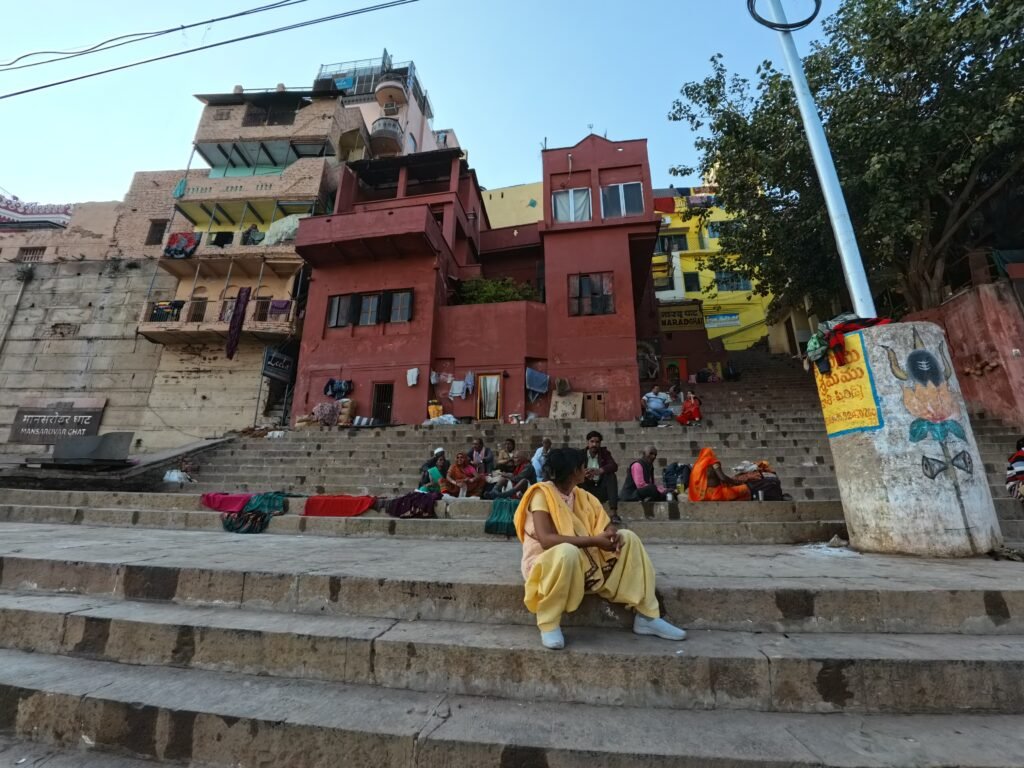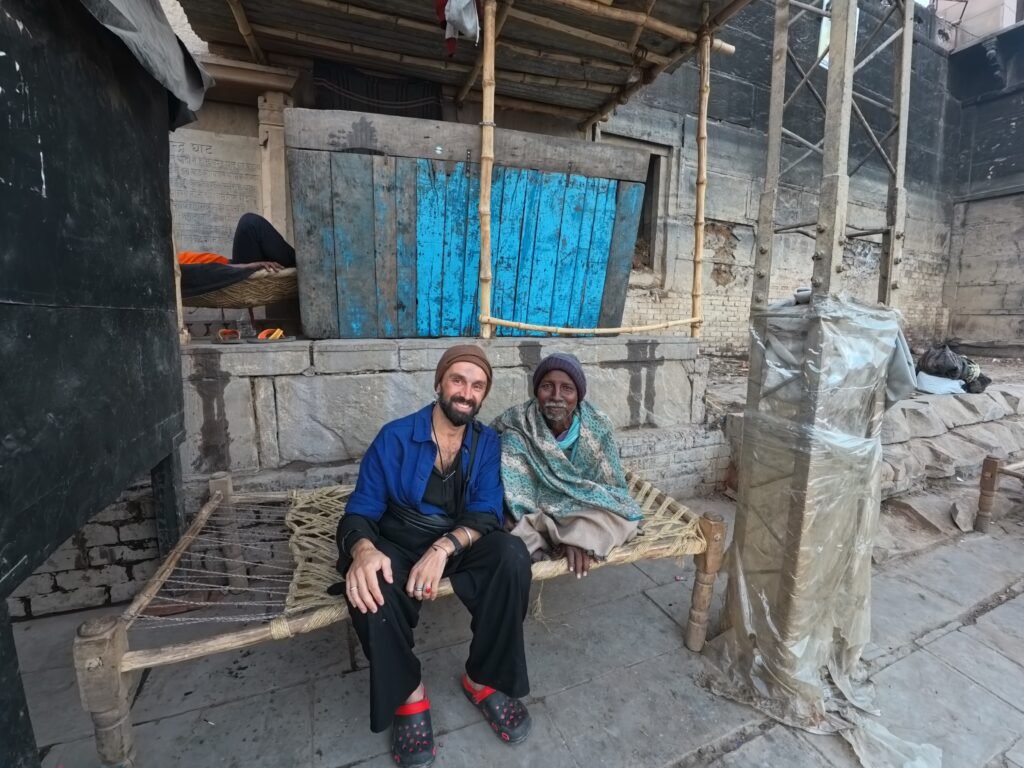The Road from Prayagraj: A Second Trial
The morning after our symbolic lunch-breakfast, we began our departure from Prayagraj. It turned out to be just as challenging as our arrival. Crowds of pilgrims, like three days before, were trying to leave the city alongside us. We had to take a bus to Varanasi with no train tickets available. Fate had a déjà vu in store for us — another desperate chase after a bus, just like the one we’d faced trying to reach the Maha Kumbh Mela.
I won’t bore you with the chaotic details, but it felt like someone—or something—was testing us again. Perhaps it was a kind of entry ritual to the city of death: Varanasi. Instead of a few hours, the journey took nearly the whole day.
That evening, we split across different hotels, planning to regroup the next morning and decide on more permanent lodging.
First Light in Varanasi: Searching for Shelter
Varanasi welcomed us with sunshine and the same crowds we’d seen at the Kumbh Mela, flowing with us into this next destination. We scouted guesthouses in the old city recommended by Mykola and Nastya. The accommodations were basic, but their location made up for the asceticism.

Choosing not to burden myself with more discomfort, I followed Kirill’s suggestion, and we moved into a newly opened hotel with clean sheets and towels. For those unfamiliar with India — these small luxuries can be deciding factors. The rest of our group settled nearby, close to the city’s main sights and the Ganges.
Welcome to the City of Death – Varanasi
After the overwhelming impressions of the Kumbh Mela, I thought nothing could surpass it. But Varanasi had its plans. This is India’s oldest city — and one of the oldest on Earth. Devout Hindus dream of being cremated here, as it’s believed that in the fires of Varanasi, the soul has a chance to break free from the cycle of rebirth (samsara) and finally attain liberation.



For someone unfamiliar with India, arriving in Varanasi can be a shock. Imagine funeral pyres burning 24/7, 365 days a year — right on the banks of the Ganges. You can sit in front of a fire and watch human remains turn to ash.
You won’t see relatives wailing in grief — tradition demands a complete severing of ties with the dead. Once farewells are made, people don’t look back literally and symbolically. The area around the pyres attracts a strange mix: tourists, sadhus, wandering ascetics, the Aghori (a sect that worships death), and silent meditators.
Where Death is Ordinary
This isn’t a mythical scene or a private ritual. It’s daily life in Varanasi. Death here is stripped of tragedy and treated as a natural, final rite of passage before liberation.
But Varanasi is not only a city of death — it pulses with life. It’s strange, chaotic, and overwhelming at times. The old city’s alleys form a maze of temples, tea stalls, shrines, and the quiet coexistence of cows and humans. Even the air is thick — with incense, spice, sun-warmed stone, and cremation smoke.


The sacred Ganges remains the city’s beating heart. On its banks, pilgrims, sadhus, beggars, and tourists gather—eachcarrying their own fate, hopes, and prayers. At dawn, boats glide over the mirror-like water as the city awakens in golden light, reminding us that every death carries within it the seed of a new beginning.
Varanasi is a collision of worlds. It either enchants you or repels you, but it never changes. It’s indifferent to emotions, untouched by time, eternal.
The Cremation Master: Business at the Edge of Life
Who runs the cremation grounds? Business is business.
Mykola, ever resourceful, even had connections here. One was the “manager of the death grounds,” whose family had supervised these pyres for generations. I can’t recall his name — a wiry, disheveled man in a loincloth and knit cap, seated on a raised platform overlooking the fires.
Probably around sixty, with clouded yellow eyes, he speaks out of habit about his work, complains about rising costs, and subtly implies he wouldn’t mind a tip for his stories.

He manages the flow of bodies, deciding who gets burned and when. In his hands lies an ancient but still-functioning machinery of death, affecting not only the fate of the dead but the livelihood of the living who work here.
His sons tend the pyres, tossing in wood. The wealthy receive their own cremation space; the poor share flames. The caste system may be officially abolished, but in practice, it still governs many aspects of Indian life — cremation work included.
Meanwhile, Among the Living
Our group had thinned a bit in Varanasi. Nastya and Svetlana missed a day of excursions due to illness or, more precisely, exhaustion.
Annapurna, as usual, had vanished — likely drawn again to her rainbow-hued spiritual companions.
That left Mykola, Kirill, and me to explore. My bottomless curiosity soon led us straight into the lair of the Aghori — but that story deserves its own space.
Continue exploring Varanasi:
👉 Between Life and Flame – Tales from the Ganges offers deeper reflections on death rituals and the spiritual rhythm of the Ganges.
👉 Journey Through Varanasi – Saturn, Sound, and Spirit dives into myth, music, and meaning under the city’s starry sky.
This article is part of a travel series exploring India. Read the full journey below:
Articles in This Series
- The Word Was with God – How India Found Me
A personal and spiritual awakening begins in India’s heartland. - Delhi Shock – My First Night in India
Raw impressions from the chaotic, vibrant capital. - The Divine Heart of India – Vrindavan, Krishna, and Rama
A deep dive into sacred cities and mythic lore. - Madness or Faith? A Pilgrimage to Maha Kumbh Mela
Encountering the world’s largest religious gathering. - Exploring Hinduism’s Greatest Festival – Maha Kumbh Mela 2025
A guide and reflection on faith, crowds, and ritual. - To Be or Not to Be: On the Eve of the Great Bathing
Facing existential questions on the threshold of the sacred. - Where the Fires Burn – First Encounters with Varanasi
A visceral arrival in India’s most mystical city. - Between Life and Flame – Tales from the Ganges
Reflections on death, devotion, and the river’s eternal flame. - Journey Through Varanasi – Saturn, Sound, and Spirit
Myths, music, and meaning in India’s spiritual capital. - Puttaparthi: A Dream Made Real
A village transformed by faith: the story of Sathya Sai Baba’s birthplace. - At the Edge of the Universe – A Journey Through Puttaparthi
A cosmic path of devotion, silence, and the soul’s unfolding.

